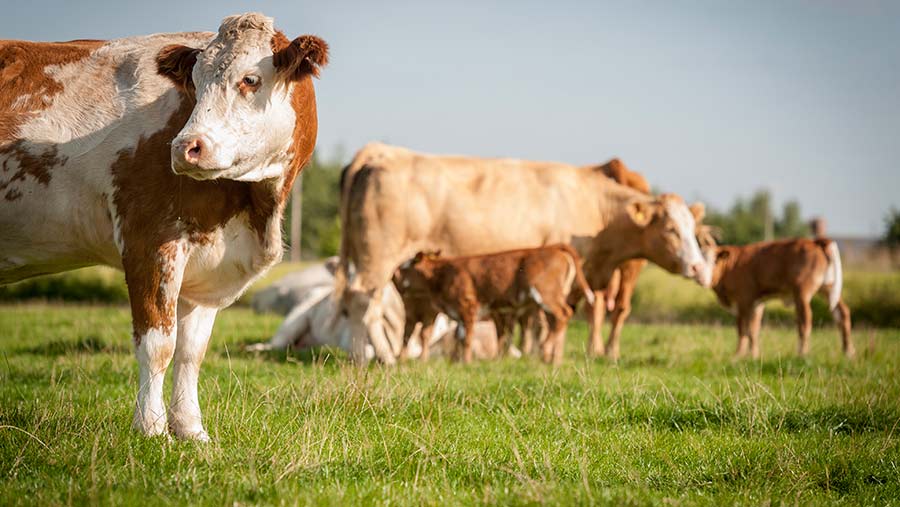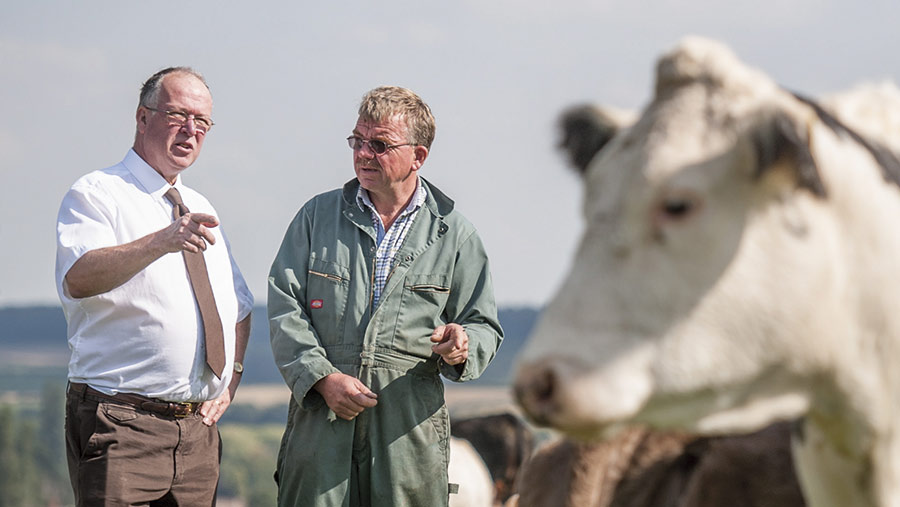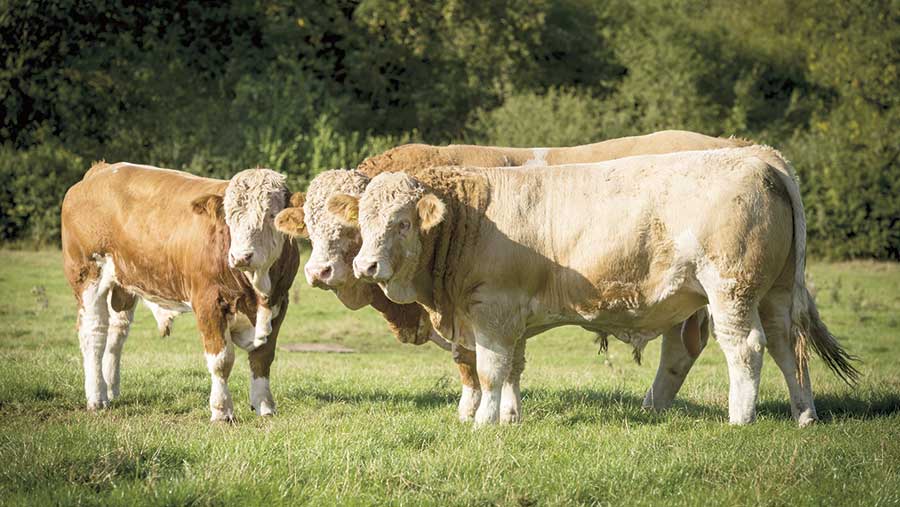Finishing results reveal high reliability of EBVs
 © Jim Varney
© Jim Varney Repeating a trial comparing the performance of terminal beef sires has shown estimated breeding values (EBVs) are highly reliable, with higher genetic merit progeny outperforming calves bred from bulls with lower terminal indices.
In 2016, when Harper Adams University first compared the performance of 2015-born progeny from two Simmental bulls – one within the top 1% of the breed and another within the top 10%.
It found calves from the bull with the higher index recorded carcass weights 12.7kg heavier when all calves were slaughtered at a similar age.
See also: Beef Focus Farm: How reducing waste is maximising beef margins
Researchers have since repeated the 2016 study using the same bulls in the same suckler herd to examine the reliability of EBVs.
The results of that trial at Ian Willison’s Williamswood Farm in Nottinghamshire, published exclusively by Farmers Weekly, shows, once again, bull calves sired by the top 1% index bull recorded significantly higher daily carcass gains and slaughter and carcass weights.
Simon Marsh, principal beef lecturer at Harper Adams, who led both trials, says the results demonstrate EBVs are repeatable.
“The message here is have faith in EBVs with decent accuracy levels. They are reliable, highly repeatable and accurate.”

(Left to right) Simon Marsh and Ian Willison © Jim Varney
The results
In this latest study, the higher carcass weights of the 2016-born bull calves from the top 1% index bull were 10.6kg heavier than progeny from the top 10% bull.
This was worth an extra £42 a head at a base carcass price of £3.50/kg, taking into account penalties for heavy weights.
Mr Marsh describes the performance of the calves from both Simmental bulls as “outstanding” with carcass weights of 371.9kg-382.5kg at just 380 days.
“This smashes the AHDB Beef & Lamb target for intensively finishing suckler bulls of a 350kg carcass at 14 months old,” he says.
The bulls were finished at just over 12 months old.
“This almost produces a ‘cycle of perfection’ with the old calf being slaughtered when the new one is born,” adds Mr Marsh.

© Jim Varney
This is the seventh study carried out by Harper Adams to compare the performance of progeny from bulls with different terminal indexes.
“All seven have shown that with bulls with reasonably high levels of accuracy, that EBVs work with significantly improved performance recorded from bulls with better figures,” says Mr Marsh.
The bulls used in the trial were Dirnanean Bradley (terminal Iindex +137 – top 1%) and Omorga Volvo (terminal index +93 – top 10%).
Results showed:
- Volvo’s calves recorded heavier birth weights than Bradley’s and an improved calving ease, contrary to the EBVs of the sires
- Volvo’s calves also had higher daily liveweight gains (DLWGs) and 200-day weights contrary to Bradley’s better EBVs for 200-day weights
- However, post-weaning calves sired by Bradley overtook those of Volvo
- Bradley sons finished two days quicker on average and recorded higher DLWGs from weaning to slaughter of 1.86kg compared with 1.70kg
- This resulted in higher carcass weights for Bradley’s calves – 10.6kg (382.5kg versus 371.9kg)
- The calves sired by Bradley in the 2016 trial were leaner with a fat classification of 3= compared with 3+/4- for progeny from Volvo which mirrors the fat depth EBVs. Bradley has a fat depth EBV of -1.2mm compared with Volvo at 0.0 mm. Calves from Bradley in 2017 were again slightly leaner.
Calving characteristics and growth rates to 200 days (bull calves) |
||
|
Sire |
Bradley (top 1%) |
Volvo (top 10%) |
|
Gestation length (days) |
285 |
287 |
|
Calving ease (1-6) 1 = unassisted, 6 = elective surgery (caesarean) |
1.7 |
1.2 (2 assists in 19 cows) |
|
Birthweight (kg) |
45.5 |
50.9 |
|
200-day weight (kg) |
346 |
352 |
|
DLWG (kg) |
1.50 |
1.50 |
Slaughter performance of Ian Willison’s bull calves |
||
|
Sire |
Bradley (top 1%) |
Volvo (top 10%) |
|
Slaughter age (months) |
12.5 (381) |
12.4 (379) |
|
Slaughter weight (kg) |
671 |
652 |
|
DLWG wean to slaughter (kg) |
1.86 |
1.70 |
|
DLWG from birth (kg) |
1.65 |
1.59 |
|
Carcass weight (kg) |
382.5 |
371.9 |
|
Carcass DG from birth (kg) |
1.01 |
0.98 |
|
Conformation score (1-15) |
11.3 (U=) |
10.8 (U=) |
|
Fat class (1-15) |
7.8 (3=) |
8.1 (3=) |
|
Carcass price (p/kg base at £3.50/kg) |
3.65 |
3.64 |
|
Carcass value (£) |
1,396 |
1,354 |
About Williamswood Farm
The 2016 and 2017 trials were hosted by Ian Willison who runs a suckler herd of 105 mostly Simmental cross British Blue cows.
Home-bred replacement heifers calve at 21-23 months old with the herd calving indoors from mid-late July.
Cows and their calves are turned out to grass as quickly as possible until mid-end October when they are housed. Bull calves are offered creep feed from four weeks old.
Cows are artificially inseminated in October and November and a sweeper bull then runs with the herd.
Nutrition
Bull calves are weaned when the cows are turned out in April and are intensively finished on good quality maize silage and blend total mixed ration (TMR) fed on a 40:60 ratio on a dry matter basis.
The blend is formulated from barley, beet pulp, biscuit meal, distillers, hipro soya, maize gluten, molasses and minerals with the TMR containing 54% DM, 12.4ME, 16.1% CP (in DM) and 28% starch (in DM).
The silage and blend intakes averaged 13.5kg (4.1kg DM) and 7.2kg (6.3kg DM) a head a day respectively.
Market
The bulls are slaughtered at Foyles at Melton Mowbray.
Heifer calves, which are not fed creep after Christmas, are turned out with their dam and weaned in June.
Thanks to the farm’s high herd health status, surplus heifers not required for replacements are sold at a premium at 15-months-old for use as recipients in embryo transfer programmes.
Why use EBVs?
Mr Willison never selects a bull without considering EBVs. “They give us an insight into what a bull is likely to do for us, without recording or EBVs you are working blind.
“In the past we have selected bulls without EBVs or those with poor EBVs and it has never produced positive results.”
Calving ability is the EBV he values the highest. “A dead calf is no good to anyone,” he says.
“If you are looking for ease of calving it is no longer good enough to just select a particular breed, you have to look at individual animals within that breed.”
